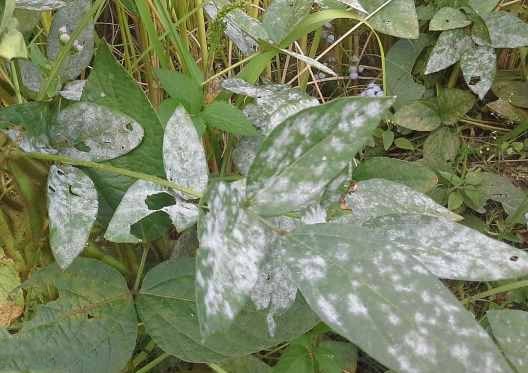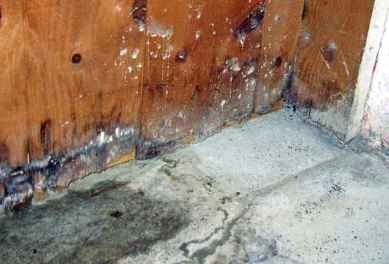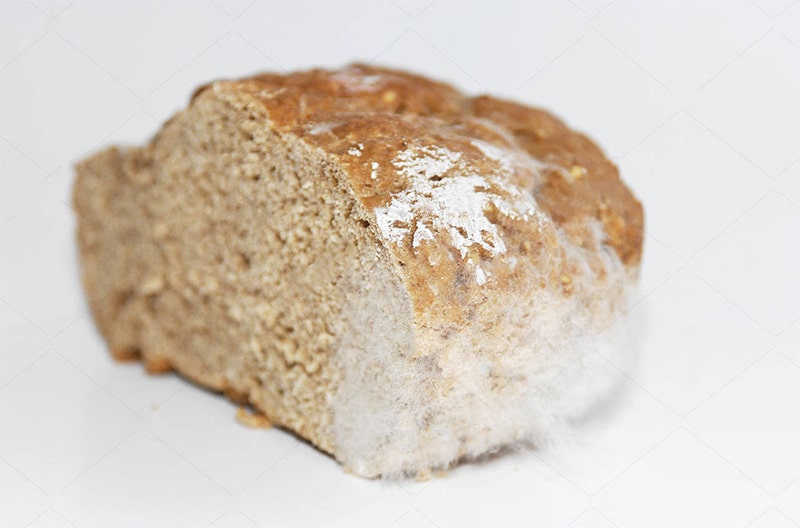White mold is a terminology used to describe mould species that may be appearing as white and got a powdery texture. This mold is always found growing at homes; an example of white mold pieces that grow at home are Cladosporium, Penicillium, and aspergillus.
When a mold is white, it may indicate that its pores have no pigment and are always determined by the kind of material the mold is developing in.
White mold on bread
AS we all know, molds grow on many things, and food is one of them.
In most cases, you see mold growing on bread. White mold, as we know, is a type of fungi, and its spores are frequently in the air; bread gives an inviting home for the mold spores.
Naturally, molds grow on bread, the reason being spored land on it and begin to multiply. The growth in bread can be quick and can lead to a colony.
White mold on bread doesn’t taste right. Its odor is unpleasant, and it is always good to throw it away. Regrettably, gluten-free bread is more likely to start developing mold. If bread is stored in such an environment for a few days, it is good to do away with it and keep future loaves in a cool, dry place.
There is always white stuff that is normal on bread. These off-white or white stains which appear first within the bread and can spread onto the crust are not okay.
White molds on plants
White molds on plants are correctly known as sclerotinia stem rot.
The diseases prevail in cool growing regions and can cause massive losses during wet, cool seasons. White molds on plans are always recognized by a fluffy white growth on stems of soybean.
The initial symptoms develop from R3 to R6 as grey and change to white lesions at the nodes. Lesion always progresses rapidly above and below the nodes. They are sometimes wrapping the whole stem. And sooner than later, the white, fluffy mycelial growth covers the infected area.
This is done more so during periods of high relative humidity.
The initial foliar manifestation includes tissues, primary tissue turning grey-green, whereas vein tissue remains green. This can be mistakenly considered to any other disease like sudden death syndrome, stem rot, or stem canker.
In the long run, the leaves die and turn brown while the rest attached to the stem. This fungus will survive in the soil for a couple of years as sclerotia.
White molds can be a headache for any homeowner, especially those who are always clean freaks. White molds ruin the structural integrity by interfering with the foundation, just like the fungal termites.
White molds can cause many health complications such as dizziness, allergic relations, and respiratory infections, just like other molds. Molds, in particular, are dangerous to those who have asthma. White molds can cause woods to rot, and a house can be dumb and have a bad smell due to molds that have affected the woods in a building.
Molds, if not taken care of, can cause damages in our pockets. This means you will have to buy new tools made of wood.
White molds on a basement
 White molds on a basement are either caused by humidity or liquid water. You have to know which one of these drives mold growth before coming up with the fixing solution.
White molds on a basement are either caused by humidity or liquid water. You have to know which one of these drives mold growth before coming up with the fixing solution.
There is a common issue that brings about molds in the basement: liquid water intrusions, the leaky and cold joints; cold joints occur where the concrete floor meets a vertical foundation wall. The reason here is that these are poured at different times, and always a hairlines crack is found at the joint. When water accumulates in the soil on the other side of this joint, it will eventually flow through the crack.
Excess humidity is always expected in basements. Homeowners mostly keep the temperature of the cellar a bit lower. This increases the relative humidity. And the lower the temperature, the air volume shrinks. However, the moisture volume stays the same, and when the air cools relative amount of moisture goes up. This is because the volume of humidity hasn’t changed; here, the vapour occupies a greater percentage of a given volume of air. This is the reason why it is called relative humidity.
Vapour intrusion, concrete is much more porous. Depending on how it is cured and other factors, large quantities of water vapour can always pass through the concrete slab.
Generally, in a basement with bare concrete, water vapour is absorbed into the adjacent air before any significant issue can occur. Most people will not want to walk around on bare concrete. Usually, the hardwood floor is expensive and risky, so many structures owners opt for carpeting. But still, the moisture has nowhere to go.
Technically, the humidity can reach even via the carpet and pad, but these materials work on slowing down the movement dramatically. When the amount of water vapour is small, the moisture will eventually make its way into the adjacent air. Once the rate of moisture transport exceeds the dry out ability, mold growth will occur.
White fuzzy mold has another name, which is powder mildew. The airborne spores of the fungus cause the fuzzy mold. This fungus spore is always attached to a young leaf, where it germinates and grows, spreading to other parts of plants quickly. Fuzzy molds are dangerous, just like different molds.
To get rid of white molds, one can use baking soda. Spray the moldy area with baking soda and water, using a scrub brush to do away with molds from the surface. Secondly, one can use products that kill molds. An example of chlorine bleach destroys mold and clears any discoloration. Frequent cleaning of home appliances will help do away with molds—clean washers using hot water cycle with chlorine bleach at least once a month. Use vinegar since it is acidic and breaks down structures of mold thus killing them. When stains remain, you can do an additional scrubbing with a household cleaner.
